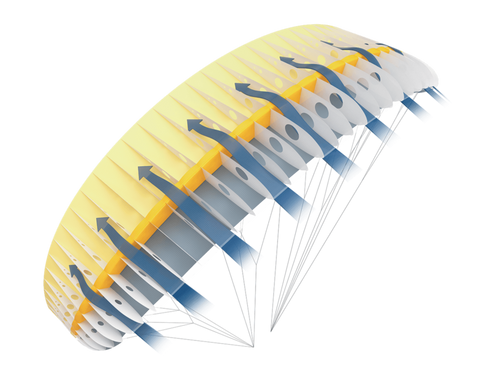What is Rast®
The question is not: Why RAST?
But the question is: Why no RAST?
But what exactly is RAST?
In the following we will explain why the RAST valve in our RC paragliders offers such a great advantage and why Rast makes absolute sense.
RAST is an acronym for:
R am A ir= dynamic pressure
S ection = sectioning/subdivision
T echnology = Technology
This system originates from manned paraglider development and was developed and patented by the company SWING.
RAST® is a technical design element that makes paragliding more predictable by dividing the paraglider canopy into different pressure zones. The glider is more stable and easier to control, especially in turbulent conditions. RAST® mode of action:
Locking valve in the RC paraglider cell illustrates:

The rear area of the paraglider canopy remains filled with air. When reopening, only the front area needs to be re-ventilated. This leads to a faster opening of the collapse and a lower loss of altitude, as the rear area remains filled with air and the paraglider therefore has a larger area to fly.

- Very harmonious inflation behavior of the paraglider!
- Comfortable and compact flight experience!
- Maximum control in challenging situations!
General advantages of RAST technology in RC paragliders:
- Easy starting, especially in difficult conditions
- High cap stability
- Effectively counteracts large-scale rattling
- No complete emptying of the canopy in the event of a malfunction – thus less loss of altitude, faster reopening, less tendency to cramming and better control over the brake
- More performance in moving air through fewer canopy movements
- More control and instantaneous control in thermals
Practical explanation of the RAST valve technology in the RC paraglider by Rico Priesnitz, the owner and development engineer of Para Aviaton RC
As we all know, a video is worth a thousand words. In the following video, we explain how a RAST model works. The RC paraglider that can be seen in the video is one of our projects currently in development. The LIBRA 3.7 RAST with an aspect ratio of 7.3 and a wingspan of 5.23 meters. The LIBRA, a "two-line" RC paraglider prototype that, like all our products, we put through its paces in South America under tough test conditions until it is ready for series production.


